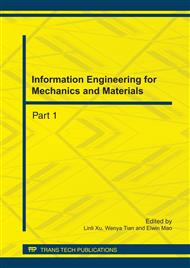[1]
Xie Jun, Han Dajian, Numerical simulation of damage detection for simply-supported reinforced concrete T-beam bridge, China Journal of Highway and Transport. 17 (2004) 45-49.
Google Scholar
[2]
S.W. Doebling, C.R. Farrar, M.B. Prime, A summary review of vibration based damage identification methods, Shock vib dig. 30 (1998) 91-105.
DOI: 10.1177/058310249803000201
Google Scholar
[3]
M. Mehrjoo, N. Khaji, H. Moharrami, A. Ba hreininejad, Damage detection of truss bridge joints using artificial neural networks, Expet Syst Appl. 35 (2008) 1122-1131.
DOI: 10.1016/j.eswa.2007.08.008
Google Scholar
[4]
Jong Jae Lee, Jong Won Lee, Jin Hak Yi, Chung Bang Yun, Hie Young Jung, Neural networks-based damage detection for bridges considering errors in baseline finite element models, J Sound Vib. 280 (2005) 555-578.
DOI: 10.1016/j.jsv.2004.01.003
Google Scholar
[5]
Y.Q. Ni, X.T. Zhou, J.M. Ko, B.S. Wang, Vibration-based damage localization in Ting Kau bridge using probabilistic neural network, Advances in structural dynamics. 2 (2000) 1069-1076.
Google Scholar
[6]
Yang JY, Zhang YY, Zhu YS, Intelligent fault diagnosis of rolling element bearing based on SVMs and fractal dimention, Mech Syst Signal Pr. 23 (2009) 384-404.
Google Scholar
[7]
Liu Lixia, Zhuang Yiqi, Liu Xueyong, Tax forecasting theory and model based on SVM optimized by PSO, Expet Syst Appl. 38 (2011) 116-120.
Google Scholar
[8]
Luke Bornn, Charles R. Farrar, Gyuhae Park, Damage detection in initially nonlinear systems, INT J ENG SCI. 48 (2010) 909-920.
DOI: 10.1016/j.ijengsci.2010.05.011
Google Scholar
[9]
Pao-Shan Yu, Shien-Tsung Chen, I-Fan Chang, Support vector regression for real-time flood stage forecasting, J Hydrol. 328 (2006) 704-716.
DOI: 10.1016/j.jhydrol.2006.01.021
Google Scholar
[10]
Aliaksei Kerhet, Mirco Raffetto, Andrea Boni, Andrea Massa, A SVM-based approach to microwave breast cancer detection, ENG APPL ARTIF INTEL. 19 (2006) 807-818.
DOI: 10.1016/j.engappai.2006.05.010
Google Scholar
[11]
Hanbing Liu, Yubo Jiao, Curvature modal shape and neural networks-based damage identification for simply supported T-beam bridge, J Jilin univ. (In Press).
Google Scholar


